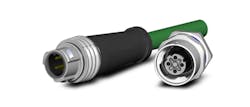What’s the Difference: Identifying Cordset Options for Automation Sensors
At a Glance:
- It’s important to use cordsets and cable assemblies that enable proper use of automation sensors at every level in the automation pyramid.
- M12 push-pull connector technology allows for significant space savings with the plug-and-play style connection.
- The key is to match the right cable with the application needs.
Combining the physical world with IIoT requires proper interfacing between the hardware (connectors, cordsets, sensors, etc.) and the software. Sensors play an integral part in this exploding market as well as the components around them—now at every level of the automation pyramid. Yet, in order to leverage a sensor’s full potential, you must take connectors and cordsets into consideration.
The automation pyramid classifies various IT considerations for different levels of automation in industrial production plants. Every level has its own unique tasks and infrastructure:
- Level 0 — The field level is the lowest level of the pyramid. It has sensors and actuators for collecting and monitoring production data and executing commands. Here, the most common M12 A-coded cordsets can be found for signal transfer (I/O). The number of pin positions vary from two pins up to 12 pins.
- Level 1 — The control level for carrying the infrastructure for controlling and steering the devices in Level 0 that perform the actual tasks. Here data is collected from all sensors, actuators and other devices and translated to actionable executed tasks. Fieldbus and Ethernet connections are utilized at this level.
- Level 2 — This supervisory level pertains to monitoring, supervising and data acquisition from operational functions through a process management system.
- Level 3 — The planning level uses a computer management system to monitor the entire manufacturing process.
- Level 4 — The enterprise operational management level, which includes interfaces for general production planning and order management through an enterprise resource planning system.
- Level 5 — The highest level of the automation pyramid is the Cloud, and is a hub for digital transformation of the factory.
It’s important to use cordsets and cable assemblies that enable proper use of automation sensors at every level in the automation period. Doing so will help provide the network architecture required to fully enable Industry 4.0.
In addition, systems continue to get smaller as miniaturization grows in popularity. For space-saving reasons, there’s an increased need of components that are both small and help increase sensor accuracy and response time. That’s what makes M12 connectors a primary driver of IIoT and new machine design.
There are multiple styles of M12 connectors available on the market today, and they’re all suited for different purposes. Here’s what you need to consider when making your M12 selection.
A-code (Used for Sensor/Actuators)
The most common M12 A-coded cordsets can be found at the lowest level of the automation pyramid for signal transfer (I/O). The number of pin positions vary from 2, 3, 4, 5, 8, up to 12 pins. A-code cable assemblies are designed for applications such as sensors and robotics, as well as production machinery and equipment where extreme temperatures and harsh environments are likely. They are also ideal for non-industrial applications where compact, robust and reliable connections are required to withstand rigorous environmental elements.
B-code (Used for Fieldbus Applications)
B-coded cordsets support Fieldbus connections for PROFIBUS and Interbus, found in 2-pin and 5-pin configurations. Fieldbus networks tend to be the most practical at the lowest level of the automation pyramid. In addition, they are a critical element of Industry 4.0, IIoT and more for end devices that do not require the bandwidth but do need the ability to have power and signal in the same cable.
Other Fielbus networks include CANbus and DeviceNet, which typically require M12 A-coded in 5 pins.
D-code (Used for Ethernet applications)
D-code interfaces support Ethernet protocols (including Industrial Ethernet, PROFINET, Ethernet/IP and EtherCat). Ethernet is rapidly becoming the technology of choice for higher-level industrial control applications that call for real-time data. To support this application type, we use M12 D-coded 4 pin twisted pair cable assemblies.
A-code through D-code connectors have been around the longest in the industry, and can be found in a variety of applications.
X-code (Used for High-Speed 10 GB Ethernet)
X-code connectors, on the other hand, are a more recent advancement. X-code can handle Ethernet connection speeds up to 10 GB, which is best for applications when you need to collect extremely accurate data. For example, a vision application that uses a camera requires the ability to capture and transmit very precise data of a moving force in order to operate in a productive and safe manner.
The M12 X-code 8-pin cable assembly meets multiple requirements in order to allow smooth, clean data transfers through the cable. With the 10 GB/second transmission rate, it stops functioning only as a cable and connector. It is truly an essential part of the industrial automation industry to capture and transmit data in a quick and precise manner.
In addition, TE Connectivity now manufactures a right-angle X-code cordset that maintains the 10 GB/second transmission rate—a feat in overcoming molding and shielding challenges. They’re quite compact at only 36 mm high, so they can fit into confined areas.
L-code (Used for Industrial Power Applications)
A recent extension to the M12 connector lineup is the M12 L-code power connectors. L-code connectors offer a compact high-power solution for automation devices. They can handle up to 16A per pin (these come either in 4-pin or 5-pin (4+FE) delivering four times the power of standard M12 connectors while providing reliable and efficient power supply. The L-code is ideal for factory automation and use in harsh and wet industrial environments.
In addition, they take up to 40% less space than traditional 7/8-in. connectors typically used for high-power connections, allowing for a more compact build. Its small footprint helps customers embrace the miniaturization trend without sacrificing quality.
Push-pull
Push-pull connectivity is a trend across the industry in different styles, configurations and materials. However, earlier versions used secondary components and adapters to make it a true push-pull configuration. This was time-consuming and complex.
Now, M12 push-pull configurations have been standardized with IEC 61076-2-012. By establishing a worldwide industrial industry standard for circular connectors, we can add a faster, easier and more reliable installation and connection method to the M12 market. In addition, the new standard is fully backwards-compatible with pre-installed M12s.
International standardization benefits all applications in which M12 push-pull would be used, as it enables the lower levels of automation sensors and actuators on the production floor to be connected to higher levels where data is transmitted and communication network protocols are occurring.
M12 push-pull connectivity also allows for significant space savings with the plug-and-play style connection, which is critical as components get smaller to meet miniaturization demands. It is spaced well for applications where there are significant space restrictions—either in the machine itself or the operating area in which the machine will be used.
Future-proof with M12
Regardless of which M12 configuration is the right fit for your application, overall flexibility is key. Look for suppliers that can provide a wide range within their portfolio to meet not only standard application requirements, but also those with harsh industrial application environments. Especially for cordsets, it is important to match the right cable with the application needs. For example, one could choose economical solutions (like PVC cables) or more high-end, flexible cables (like PUR & TPE) for drag chain and torsion applications.
Look for cordset options and cable assemblies that not only meet today’s needs but will set you up for the necessary developments three to five years from now—including compatibility with Single Pair Ethernet. It may feel like a fundamental change in the short-term, but it will save you from redesigning entire systems due to market development.
Sofia Sevastidou is a global product manager with TE Connectivity, a manufacturer of advanced connectivity and sensors solutions.
Editor's Note: Machine Design's Women in Science and Engineering (WISE) hub compiles our coverage of gender representation issues affecting the engineering field, in addition to contributions from equity seeking groups and subject matter experts within various subdisciplines. Click here for more.



